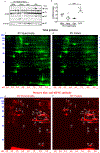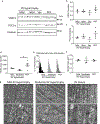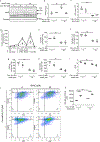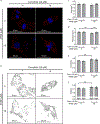4HNE Impairs Myocardial Bioenergetics in Congenital Heart Disease-Induced Right Ventricular Failure
- PMID: 32806952
- PMCID: PMC7606813
- DOI: 10.1161/CIRCULATIONAHA.120.045470
4HNE Impairs Myocardial Bioenergetics in Congenital Heart Disease-Induced Right Ventricular Failure
Abstract
Background: In patients with complex congenital heart disease, such as those with tetralogy of Fallot, the right ventricle (RV) is subject to pressure overload stress, leading to RV hypertrophy and eventually RV failure. The role of lipid peroxidation, a potent form of oxidative stress, in mediating RV hypertrophy and failure in congenital heart disease is unknown.
Methods: Lipid peroxidation and mitochondrial function and structure were assessed in right ventricle (RV) myocardium collected from patients with RV hypertrophy with normal RV systolic function (RV fractional area change, 47.3±3.8%) and in patients with RV failure showing decreased RV systolic function (RV fractional area change, 26.6±3.1%). The mechanism of the effect of lipid peroxidation, mediated by 4-hydroxynonenal ([4HNE] a byproduct of lipid peroxidation) on mitochondrial function and structure was assessed in HL1 murine cardiomyocytes and human induced pluripotent stem cell-derived cardiomyocytes.
Results: RV failure was characterized by an increase in 4HNE adduction of metabolic and mitochondrial proteins (16 of 27 identified proteins), in particular electron transport chain proteins. Sarcomeric (myosin) and cytoskeletal proteins (desmin, tubulin) also underwent 4HNE adduction. RV failure showed lower oxidative phosphorylation (moderate RV hypertrophy, 287.6±19.75 versus RV failure, 137.8±11.57 pmol/[sec×mL]; P=0.0004), and mitochondrial structural damage. Using a cell model, we show that 4HNE decreases cell number and oxidative phosphorylation (control, 388.1±23.54 versus 4HNE, 143.7±11.64 pmol/[sec×mL]; P<0.0001). Carvedilol, a known antioxidant did not decrease 4HNE adduction of metabolic and mitochondrial proteins and did not improve oxidative phosphorylation.
Conclusions: Metabolic, mitochondrial, sarcomeric, and cytoskeletal proteins are susceptible to 4HNE-adduction in patients with RV failure. 4HNE decreases mitochondrial oxygen consumption by inhibiting electron transport chain complexes. Carvedilol did not improve the 4HNE-mediated decrease in oxygen consumption. Strategies to decrease lipid peroxidation could improve mitochondrial energy generation and cardiomyocyte survival and improve RV failure in patients with congenital heart disease.
Keywords: heart failure; heart ventricles; hypertrophy; lipid peroxidation; mitochondria.
Conflict of interest statement
Figures






Similar articles
-
Transcriptomic and Functional Analyses of Mitochondrial Dysfunction in Pressure Overload-Induced Right Ventricular Failure.J Am Heart Assoc. 2021 Feb 16;10(4):e017835. doi: 10.1161/JAHA.120.017835. Epub 2021 Jan 30. J Am Heart Assoc. 2021. PMID: 33522250 Free PMC article.
-
Increased in vivo mitochondrial oxygenation with right ventricular failure induced by pulmonary arterial hypertension: mitochondrial inhibition as driver of cardiac failure?Respir Res. 2015 Feb 3;16(1):6. doi: 10.1186/s12931-015-0178-6. Respir Res. 2015. PMID: 25645252 Free PMC article.
-
Mesenchymal stem cells preserve neonatal right ventricular function in a porcine model of pressure overload.Am J Physiol Heart Circ Physiol. 2016 Jun 1;310(11):H1816-26. doi: 10.1152/ajpheart.00955.2015. Epub 2016 Apr 22. Am J Physiol Heart Circ Physiol. 2016. PMID: 27106046
-
The vulnerable right ventricle.Curr Opin Pediatr. 2015 Oct;27(5):563-8. doi: 10.1097/MOP.0000000000000268. Curr Opin Pediatr. 2015. PMID: 26262580 Free PMC article. Review.
-
Right ventricular failure in congenital heart disease.Curr Opin Pediatr. 2019 Oct;31(5):604-610. doi: 10.1097/MOP.0000000000000804. Curr Opin Pediatr. 2019. PMID: 31356354 Free PMC article. Review.
Cited by
-
Accelerated Cardiac Aging in Patients With Congenital Heart Disease.Front Cardiovasc Med. 2022 May 26;9:892861. doi: 10.3389/fcvm.2022.892861. eCollection 2022. Front Cardiovasc Med. 2022. PMID: 35694664 Free PMC article. Review.
-
Molecular Mechanism of Aerobic Exercise Ameliorating Myocardial Mitochondrial Injury in Mice with Heart Failure.Int J Mol Sci. 2025 Feb 27;26(5):2136. doi: 10.3390/ijms26052136. Int J Mol Sci. 2025. PMID: 40076760 Free PMC article.
-
4-Hydroxy-2-Nonenal Promotes Cardiomyocyte Necroptosis via Stabilizing Receptor-Interacting Serine/Threonine-Protein Kinase 1.Front Cell Dev Biol. 2021 Oct 1;9:721795. doi: 10.3389/fcell.2021.721795. eCollection 2021. Front Cell Dev Biol. 2021. PMID: 34660582 Free PMC article.
-
A Novel ALDH2 Activator AD-9308 Improves Diastolic and Systolic Myocardial Functions in Streptozotocin-Induced Diabetic Mice.Antioxidants (Basel). 2021 Mar 13;10(3):450. doi: 10.3390/antiox10030450. Antioxidants (Basel). 2021. PMID: 33805825 Free PMC article.
-
Potential roles of 4HNE-adducted protein in serum extracellular vesicles as an early indicator of oxidative response against doxorubicin-induced cardiomyopathy in rats.Curr Res Toxicol. 2023 Nov 3;5:100134. doi: 10.1016/j.crtox.2023.100134. eCollection 2023. Curr Res Toxicol. 2023. PMID: 37964944 Free PMC article.
References
-
- Altmann K, Printz BF, Solowiejczyk DE, Gersony WM, Quaegebeur J and Apfel HD. Two-dimensional echocardiographic assessment of right ventricular function as a predictor of outcome in hypoplastic left heart syndrome. Am J Cardiol. 86:964–968. - PubMed
-
- Bogaard HJ, Abe K, Vonk Noordegraaf A and Voelkel NF. The right ventricle under pressure: cellular and molecular mechanisms of right-heart failure in pulmonary hypertension. Chest. 2009;135:794–804. - PubMed
-
- Fine NM, Chen L, Bastiansen PM, Frantz RP, Pellikka PA, Oh JK and Kane GC. Outcome prediction by quantitative right ventricular function assessment in 575 subjects evaluated for pulmonary hypertension. Circ Cardiovasc Imaging. 2013;6:711–721. - PubMed
-
- Haddad F, Hunt SA, Rosenthal DN and Murphy DJ. Right ventricular function in cardiovascular disease, part I: Anatomy, Physiology, Aging, and Functional Assessment of the Right Ventricle. Circulation. 2008;117:1436–1448. - PubMed
Publication types
MeSH terms
Grants and funding
LinkOut - more resources
Full Text Sources
Medical

